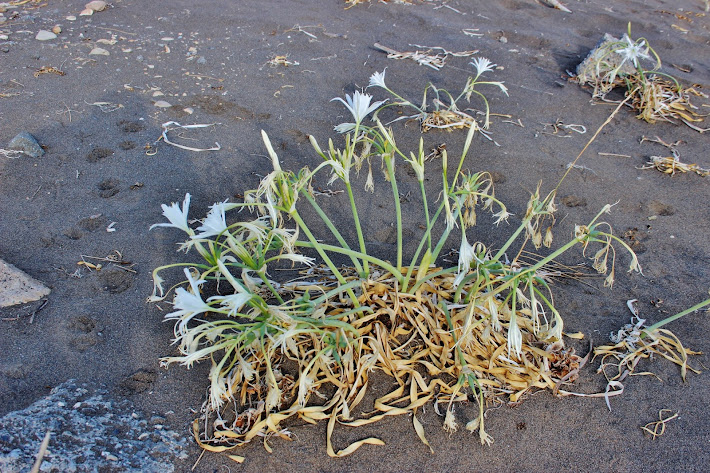Red Data Book category
 Pancratium maritimum, or sea daffodil, is a species of bulbous plant native to both sides of the Mediterranean region and Black Sea from Portugal, Morocco and the Canary Islands east to Turkey, Syria, Israel and the Caucasus. It can also be seen on the south Bulgarian and north Turkish and Georgian coasts of Black Sea, where it is threatened with extinction. It is also naturalized in southern California, Bermuda and the Azores.
Pancratium maritimum, or sea daffodil, is a species of bulbous plant native to both sides of the Mediterranean region and Black Sea from Portugal, Morocco and the Canary Islands east to Turkey, Syria, Israel and the Caucasus. It can also be seen on the south Bulgarian and north Turkish and Georgian coasts of Black Sea, where it is threatened with extinction. It is also naturalized in southern California, Bermuda and the Azores.
Pancratium maritimum grows on beaches and coastal sand dunes, often with much of the leaves and scapes buried in the sand. Other vernacular names are sand daffodil, sand lily and lily of St. Nicholas. The specific epithet maritimum means "of the sea"

 Pancratium maritimum is a bulbous perennial with a long neck and glaucous, broadly linear leaves, evergreen, but the leaves often die back during hot summers. Scape to 40 centimetres (16 in). Flowers 3–15 in an umbel, up to 15 cm (6 in) long, white. Corona two-thirds as long as the tepals. The flowers have a pleasing, exotic and very subtle lily scent, which only becomes apparent during still, windless summer nights that allow the delicate fragrance to become perceptible. Flowering is from August to October
Pancratium maritimum is a bulbous perennial with a long neck and glaucous, broadly linear leaves, evergreen, but the leaves often die back during hot summers. Scape to 40 centimetres (16 in). Flowers 3–15 in an umbel, up to 15 cm (6 in) long, white. Corona two-thirds as long as the tepals. The flowers have a pleasing, exotic and very subtle lily scent, which only becomes apparent during still, windless summer nights that allow the delicate fragrance to become perceptible. Flowering is from August to October Pancratium maritimum is pollinated by a hawk-moth named Agrius convolvuli. These insects visit the flower only when the speed of the wind is under 2 metres per second (6.6 ft/s). Even if the species is pollinated in an artificial way during windy weather the pollination is not effective. Pancratium maritimum is not receptive to its own pollen and must be cross-pollinated.
Pancratium maritimum is pollinated by a hawk-moth named Agrius convolvuli. These insects visit the flower only when the speed of the wind is under 2 metres per second (6.6 ft/s). Even if the species is pollinated in an artificial way during windy weather the pollination is not effective. Pancratium maritimum is not receptive to its own pollen and must be cross-pollinated.
Easily grown but requires a very sunny position and a very well drained, sandy soil. Needs hot summers to induce flowering and is often a shy bloomer in cooler climates. Hardy to USDA zone 8. Tolerates temperatures down to about −5 °C (23 °F). Propagation by seeds or division after flowering. Seedlings may flower in their third or fourth year.From Wikipedia, the free encyclopedia
Photos Davlos by George Konstantinou




No comments:
Post a Comment